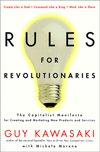Review: Rules For Revolutionaries (Book)

Author: Guy Kawasaki with Michele Moreno
ISBN: 0887309968
My three-word review is “Buy this book.” Now, if this were all I had to say about Guy’s latest, my editor would have two cows, not to be confused with tucows, so, I’ll try explain my gut reaction, without making it sound like a book report. In reviewing this book, finding something new to say is tough, as I’m sure many of you have read the several positive reviews that are already out there. So, if I say something you’ve heard elsewhere, I apologize in advance. :-)
The subtitle is The Capitalist Manifesto for Creating and Marketing New Products and Services. It’s divided into three sections, Create Like a God, Command Like a King, and Work Like a Slave, plus a conclusion. There are three chapters in each section, with titles that you may or may not have heard of, including “Think Different.” Guy plainly admits to ripping off concepts he’s heard or put to use elsewhere. In this case, it’s not necessarily a bad thing. One company that thinks different is Gillette. That’s right; they have an on-site shaving lab for their employees to use and give feedback. The theory is that if your own employees won’t use your product, why should the consumers? This comes from a section of the book aptly titled, Eat Your Own Dog Food. Of course, I’m sure the people at Alpo don’t do this, but maybe they should. A question I constantly ask myself while writing scripts is, “Would I want to see this on the big screen?” Usually, I come back with a yes.
So, after Creating Like a God, Commanding Like a King comes next. Making the next innovative product is simply not enough. For a revolution to succeed, someone has to take charge and make the tough, insightful, and strategic decisions. Breaking Down the Barriers involves taking ignorance, inertia, complexity, and price, and turning them to your advantage. Acceptance of your product in the current marketplace is the goal. I write a screenplay. Should the studios spend $40 million so that it can be coming soon to a theater or drive-in near you?
Next, Make Evangelists, Not Sales. Create a product so good, that the people that buy it tell others. By generating good word of mouth, your product or service will sell itself. After all, over 20 million Macintosh users can’t be wrong. Finally, Avoid Death Magnets. Death magnets are dumb management habits. I’m reminded of Dilbert’s boss. Management types can’t seem to help themselves out of their mental rut even though death magnets are stupid. I read a recent study where middle management and above spends an average of 42% of its time in meetings. Revolutionaries? I think not.
The next step? Work Like a Slave. Exactly what the name implies. My favorite quote from this section? “Guy is into the weirdest things. No wonder Apple is having problems.” This chapter boils down to going out and doing it yourself, when all else fails. Notice subtleties. Don’t rely on professionals. And my favorite, “be your own librarian. Read: use the Internet wisely.” How does one work like a slave?
First, Eat Like a Bird, Poop Like an Elephant. Ok, pretty gross, I know, but observe, that typical bird eats 47 times its weight each day. Translated to human terms: gather as much information as you can about the market, your customers, and your competition. To succeed you have to turn around and put out the information you gather in a meaningful way.
Next, Think Digital, Act Analog. Ultimately, the computer you’re reading this on is just a tool, and real live human interaction with your customers is the way to go. And finally, Don’t ask customers to do what you wouldn’t. I alluded to this above, however, it bares repeating: Would I pay $8.75 to see the movie I just wrote?
As you can see, even actor/writer/director/producers like myself can get something out of this book. In conclusion, as I said above, buy this book. Read it, and convince others to buy a copy. Do this, and you will have put most of the principles that you just read into use. Guy has provided an Internet mailing list to discuss the principles presented in his book. Don’t take my word for it; you can either sign up for the list by sending an e-mail to rfr-on@lists.garage.com, or check out the other lists available. I’ll be joining as soon as I mail off this review.
Reader Comments (0)
Add A Comment